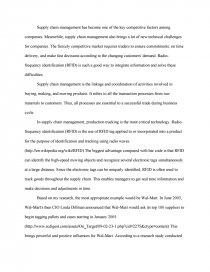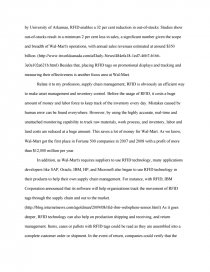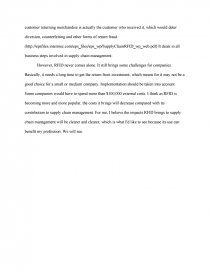Supply Chain Management - Walmart Rfid
Essay by Woxman • September 30, 2011 • Case Study • 757 Words (4 Pages) • 2,487 Views
Supply chain management has become one of the key competitive factors among companies. Meanwhile, supply chain management also brings a lot of new technical challenges for companies. The fiercely competitive market requires traders to ensure commitments, on time delivery, and make fast decisions according to the changing customers' demand. Radio-frequency identification (RFID) is such a good way to integrate information and solve these difficulties.
Supply chain management is the linkage and coordination of activities involved in buying, making, and moving products. It refers to all the transaction processes from raw materials to customers. Thus, all processes are essential to a successful trade during business cycle.
In supply chain management, production tracking is the most critical technology. Radio-frequency identification (RFID) is the use of RFID tag applied to or incorporated into a product for the purpose of identification and tracking using radio waves. (http://en.wikipedia.org/wiki/RFID) The biggest advantage compared with bar code is that RFID can identify the high-speed moving objects and recognize several electronic tags simultaneously at a large distance. Since the electronic tags can be uniquely identified, RFID is often used to track goods throughout the supply chain. This enables managers to get real time information and make decisions and adjustments in time.
Based on my research, the most appropriate example would be Wal-Mart. In June 2003, Wal-Mart's then CIO Linda Dillman announced that Wal-Mart would ask its top 100 suppliers to begin tagging pallets and cases starting in January 2005. (http://www.scdigest.com/assets/On_Target/09-02-23-1.php?cid=2275&ctype=content) This brings powerful and positive influences for Wal-Mart. According to a research study conducted by University of Arkansas, RFID enables a 32 per cent reduction in out-of-stocks. Studies show out-of-stocks result in a minimum 2 per cent loss in sales, a significant number given the scope and breadth of Wal-Mart's operations, with annual sales revenues estimated at around $350 billion. (http://www.itworldcanada.com/a/Daily-News/484efa18-1ed7-46b7-b166-3e0a102a621b.html) Besides that, placing RFID tags on promotional displays and tracking and measuring their effectiveness is another focus area at Wal-Mart.
Relate it to my profession, supply chain management; RFID is obviously an efficient way to make asset management and inventory control. Before the usage of RFID, it costs a huge amount of money and labor force to keep track of the inventory every day. Mistakes caused by human error can be found everywhere. However, by using the highly accurate, real-time and unattached monitoring capability to track raw materials, work process, and inventory, labor and land costs are reduced at a huge amount. This saves a lot of money for Wal-Mart. As we know, Wal-Mart got the first place
...
...


